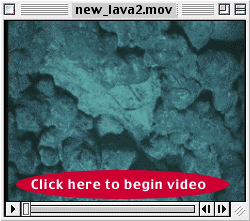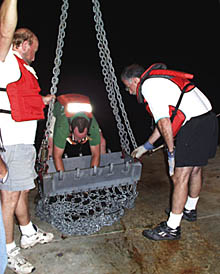|
|
TODAY'S WEATHER
Dredging for glassy seafloor lavas Last night, the wind started blowing up to 20 knots, and the seascape this morning was filled with white-caps! For the first time in two weeks, you could actually tell that we were on a rolling ship, rather than on the millpond that has been the tropical Pacific Ocean for the past few days. Today we “tied a knot” with Argo II survey lines around the new lava flow that Maya Tolstoy’s watch had discovered yesterday near 3° 23.30’N and 102° 14.36’W. Our map of the track lines for Argo II looks like strands of spaghetti that fell on the floor, all twisted and overlapping. We had to cover as much of the seafloor as possible so that we could map the edges of the new lava flow. We have found out that the flow is very small, only about the size of a football field (about 100 meters on each side). This is not too surprising because some of the other lava flows on the East Pacific Rise that we know about, such as the one near 9° 50’N, also are quite small. It is hard to believe that small eruptions like these build the ridge crest over hundreds and thousands of years, and create the ocean crust of the Earth. Tonight, we are dredging to collect samples of the new lava flow. Think about the games that you play at the fair or in the shopping mall where you have to grab toys or candy with cranes or claw-like arms. Well, in the ocean, the distance to the seafloor is much longer, the target area is much smaller, and you cannot see what you are “grabbing”! Rock dredges come in all sorts of shapes and sizes, but the ones we use consist of a chain link bag attached to a rectangular metal frame. The dredge is lowered to the seafloor on a long trawl wire, and then the ship moves very slowly dragging the dredge along the seafloor to pick up loose rocks or break rocks from the lava flows. All the while, the scientists watch the “tensiometer” that measures the tension of the trawl wire. They look for “bites” (a slow build up of tension and then a quick release) that signal a rock might have been collected. After dredging along a line for a set distance, the dredge is hauled back to the ship and the rocks can be pulled out of the chain link bag. So far, we have dragged the dredge over the new flow twice, and have collected some small pieces of the lava. It is very glassy and fresh. We suspect that is it the eruption detected by the Autonomous Hydrophone Array between May 27 and June 5, 1996, but we will have to wait until we get back to shore to actually date the rocks. More dredging and rock coring is planned for the next two days so we can collect lava from the different seafloor features that we have imaged with the DSL-120 sonar and Argo II. These lavas will be chemically analyzed when we get back to shore to help us understand how young and old lavas relate to each other, how deep in the Earth the molten rock comes from, and how it erupts on this part of the mid-ocean ridge crest.
|
|||||||||||||||||||||||||||||||||||||||||||||||||||||||||||||||||||||||||||||||||||||||||||||||||||||||||||||||||||||||||||||||||||||||||||||||||||||||||||||||||||
© 2010 Dive and Discover™. Dive and Discover™ is a registered trademark of
Woods
Hole Oceanographic Institution





